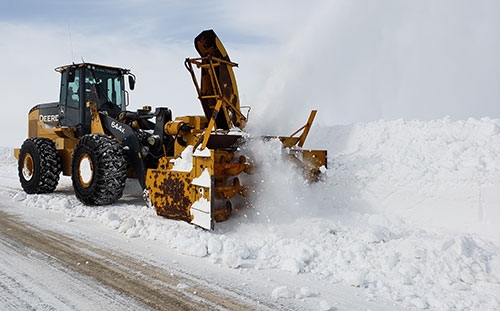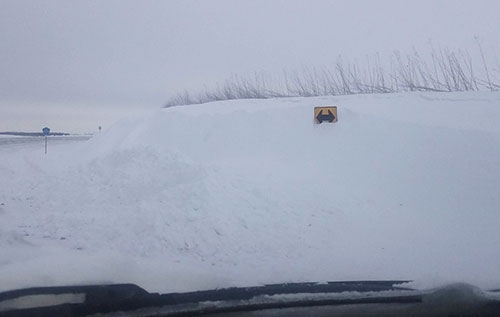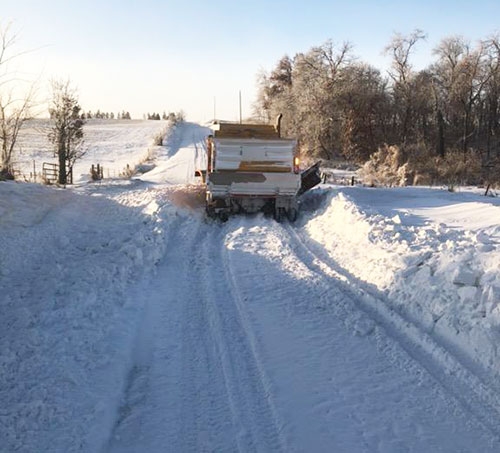You are here
Home ›Safety first: Allamakee County road crews battle unlimited elements, limited resources

Heavy equipment for heavy winter weather ... Allamakee County Secondary Roads crews have had to pull out their biggest equipment at certain times this winter to help keep Allamakee County roadways open. Pictured above is a snowblower attached to an endloader for use to help bust through heavy snowfalls and drifting, or even to help open roadside areas even further just to make more room for additional snowfall to be plowed off the roadway. Photo courtesy of the Allamakee County Secondary Roads Department.

Dealing with the impact no matter which way one turns... Heavy snowfall amounts with several storms this winter coupled with strong winds accompanying some of those storms have resulted in considerable snow levels that can not only impact roadways but also road signs, as pictured above. Photo courtesy of the Allamakee County Secondary Roads Department.

Plowing the way through winter ... Allamakee County Secondary Roads crews have had to make their way through several sizable snowfalls this winter, along with some occasional ice/freezing rain and the aftermath of 40-50 mph wind gusts blowing snow during one February storm system. Allamakee County Engineer Brian Ridenour said the County has gone through about 90% of its $500,000 budget for winter road maintenance as of the end of February and is hoping for a quiet March. Photo courtesy of the Allamakee County Secondary Roads Department.
by Lissa Blake
With 880 miles of road to maintain, Allamakee County road crews have been putting forth their best effort to combat the snow, ice and wind conditions this winter. Allamakee County Engineer Brian Ridenour recently explained what it takes to keep the roads clear and County employees and residents safe during a winter such has been experienced this year.
“We have 10 motor graders, 12 plow trucks, five loaders and 27 dedicated, dependable operators,” said Ridenour of his Allamakee County Secondary Roads Department. He said the County’s normal budget for winter maintenance is $500,000, and he says his department has already used up about 90 percent of that this winter.
“Hopefully, March will be good to us,” said Ridenour. In addition to labor, that money helps pay for around 1,200 tons of salt and 30,000 tons of sand used on County roadways.
LIMITED RESOURCES
Ridenour said although people often wonder why plows aren’t out 24 hours a day/seven days a week when winter weather strikes, limited resources have dictated the operators work only one 12-hour shift each day, from 5 a.m. to 5:30 p.m.
“There have been a lot of 12-hour days this winter, including weekends and holidays. Every storm is different and it takes experienced workers to take on the task of snow and ice removal,” he said.
EXCEPTIONS
Although the County operators are limited to one shift, he said there are several exceptions where plows may be called out beyond those hours.
“To call out snow plows beyond our normal winter hours, it has to be an emergency, and emergencies are classified as probable loss of life, serious injury has occurred or extensive loss of property is imminent,” he added.
OTHER CONSIDERATIONS
Ridenour added that regardless of the type of storm, the County’s paved roads are the first priority, next are the higher-traffic gravel roads and then lower-traffic roads.
“For a normal six-inch snowstorm, we generally can get all of our secondary roads open in 12 hours, if there is no additional accumulation or wind occurring,” he said, adding everyone agrees that snow is better than ice, just due to the difficulties of removing ice in subzero weather.
Emergencies and equipment breakdowns can delay the opening of the County’s roads as well. Ridenour further explained that although they do their best to get to all of the County’s roads following a winter storm, there can be circumstances where the County drivers do not go out.
“Sometimes, in consideration of the safety of our crew and the public, we have to call back our plows or not even go out during nasty winter storms. The decision of not going out or not plowing during a storm is usually during very windy conditions of blowing snow causing low or no visibility during a white-out,” he said.
He said he also closely monitors watches, warnings and advisories for other counties, because “weather doesn’t stop at the county line.”
“Usually the media will put out there to the public ‘no plows’ and/or ‘no tow,’ ‘travel not advised,’ and everyone should stay off the roads, if they can, until we resume plowing and travel is recommended,” he said, adding for their own personal safety and the safety of others, people should heed those warnings.
“Plowing around stranded vehicles just delays getting roads open for everybody else and causes unsafe conditions,” he said, adding it is “really frustrating” to see vehicles in the ditch.
“Sometimes there is no way our guys or the (Iowa) Department of Transportation can even get the roads open due to all the stuck vehicles,” he said.
Ridenour noted the National Weather Service and 511 Iowa Department of Transportation websites are very good resources for the public to check before driving in a winter storm.
EACH STORM IS DIFFERENT
Ridenour said each storm is different and it can be hard to predict what will happen.
“Whether it’s light or heavy snow, everything takes a little experience and a judgment call, trying to get things open as soon as possible so it’s safe for everyone,” he said. “This time of year our operators and everyone else are tired of winter and all are hopeful for an early spring.”
VERY FORTUNATE
Ridenour said his department is fortunate to have the support it does receive from so many sources.
“We are fortunate and appreciative to have reliable equipment and good employees in these storms and the support from our Board of Supervisors and community for funding to keep the roads open and safe,” he said.

